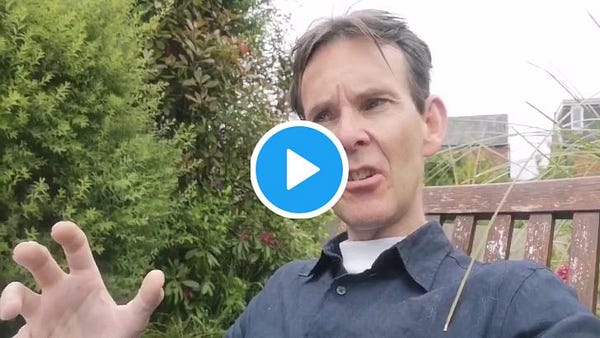
Hey folks. Happy humpday in your direction. Thanks for coming back. I hope your eyes are having a party and that it’s not all about the kitchen.
Though if you even faintly know me, you’ll know my favourite room in the house, music blaring or not, is always the one with the hob. I love seeing things in a changing state.
Talking about changed states, that’s what happened to me yesterday when I was awash with newsletters. Tuesday seems to be the day.
I talked on yesterday’s #AudioMo (which happens to be the one you’ll hear at the top of this newsletter) about how I’m hooked on other people’s lives. That’s why I find myself transfixed at their newsletters. I get my fair share of specialist ‘zines - such as Not Boring, and that one David Perrell knocks out (he’s the guy behind the Write of Passage course). But the real joy lives in the newsletters written about humans’ random goings-on.
As an aside, here’s me abusing #AudioMo privileges with a slapstick guide to making better websites.


Back on topic, and the audio at the top, this (my obsession with newsletters) is why I gave a special hat tip to Documentally (newsletter), a pal of some 11 years since we first met at Herb Kim’s incredible Thinking Digital festival. Both friendship and festival go from strength to strength. I encourage you to visit both.
What’s the matter, you say? It’s from another fave newsletter. TLDR.
TLDR aggregates fascinating news.
Subscribe for pearls like those below.
Conscious-less consciousness
Scientists - you’ll know them because they rule, change and own our world - found this yellow gunk in a forest. It was bleeding from a trunk. Only it had nothing to do with the trunk, except using it for load-bearing. The gunk was looking for food, or safety. The trunk happened to be in its way, and it was being overcome.
P. polycephalum is a mo(u)ld. A very clever one. It knows how to accomplish tasks, yet it has no
As far as organisms go, it’s unique. It has neither a brain nor a nervous system, yet it readily solves problems. Probably more complicated ones than I could do, yet apparently I have billions of neurons and a smattering of synapses. You think I’d have the home court advantage yet our jaundice-coloured pal P. polycephalum can pretty much look after itself without a headache.
The TLDR here is that the subject of this story could help AI devotees figure out how to bring what passes as consciousness to algorithms. Because that’s what AI is. And the biggest challenge that gets us beyond the Turing test into the really good stuff about AI - mimicking humans and getting all Kurzweil about it - is right here.
And all the other smart types can start debating what consciousness is, since previously we figured it was associated with electrical currents passed through mushy matter of a different kind.
Buildings that fix themselves
Carbonic anhydrase is an enzyme that when added to concrete makes it self-healing.
Think of the ramifications.
Subsidence - the end.
Earthquakes - managed.
Hurricanes - they’ll blow over.
I haven’t been this excited about structural enhancements since perovskite - the logical successor to photovoltaic cells which destroy the world and convert with some inefficiency the sun’s rays to energy.
Was this any good?










